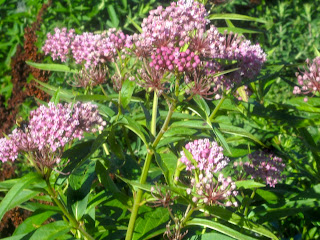 |
| SWAMP MILKWEED... |
 |
| FLOWER PANICLE... |
 |
| ...MILKY SAP |
 |
| IRONWEED |
 |
| JOE PYE WEED... |
Sunday, 8:00 AM. 63 degrees, wind WNW, calm. The sky is mostly clear with some haze. The humidity is high at 90% but the barometer is trending up at 30.18". It got quite chilly last night so I started a fire in the fireplace. The firewood I am putting up, mostly red oak with some maple and white birch, is perfectly cured and burns like coal. A few chunks burn brightly and warm the room.
It looks like a good afternoon to clean the chimney, although I normally try to avoid work on Sunday, and there is a Brewer's baseball game with the Cubs this afternoon. We'll see.
I mentioned in my blog on 8/16/2013 that the new water gardens, so called, at the recently improved Bayfield boat ramp, located at the south end of Third Street, were suffering from a lack of maintenance. Nonetheless, there are a number of good native plants still evident. Three which are in bloom at present that are very good for absorbing water (true aquatic plants are not suitable for a drainage area which is intermittently wet and dry) are swamp milkweed, Asclepias incarnata, in the milkweed family; Ironweed, Vernonia fasciculata, in the composite family; and Joe Pye weed, Eupatorium maculatum, also in the composite family.
Swamp milkweed is quite beautiful in flower, and like most of the milkweed species has a characteristic milky sap often used in herbal medicine for the treatment of pleurisy and related ailments (Asclepias was the Greek god of medicine).
Ironweed was so named by early settlers because it was thought to indicate where significant deposits of iron ore could be found. Even though this has not been proven to be the case, I will make a wild guess that since it grows in boggy or wet areas that it may actually have been something of an indicator for the presence of "bog iron," a crude source of iron ore deposits found in many places along the East Coast that was excavated and smelted into iron by early settlers, the first use being in Virginia in 1608. There were extensive mining and smelting operations in Massachusetts and elsewhere on the East Coast during the Seventeenth and Eighteenth centuries. I have seen numerous depressions where "bog iron" was dug centuries ago in the New Jersey Pine Barrens, much of it for cannonballs during the American revolution.
Joe Pye weed root is valuable in herbal medicine for the treatment of kidney stones (we can attest that it really works), and is named after an American Indian herbal healer. It is also very attractive in flower, and can be a good back-of-the-border perennial garden plant, although it only does well in quite damp soil. The whorls of leaves on the stem are a good identification characteristic.
A caviate: never attempt to use plants, wild or cultivated, for medicinal purposes unless you really know them and their physiological effects, as most medicinal plants are also poisonous to a degree, and some are deadly in the wrong amounts.
|












Reliable plastic weed barrier manufacturers like Singhal Global play a vital role in modern agriculture and gardening. Their products are engineered with durability and water permeability in mind, ensuring healthy plant growth while minimizing weeds. The plastic barriers are easy to install and last for years, offering great value. I highly recommend checking their catalog if you’re looking for dependable manufacturers that combine performance, sustainability, and cost-effectiveness in every product.
ReplyDelete